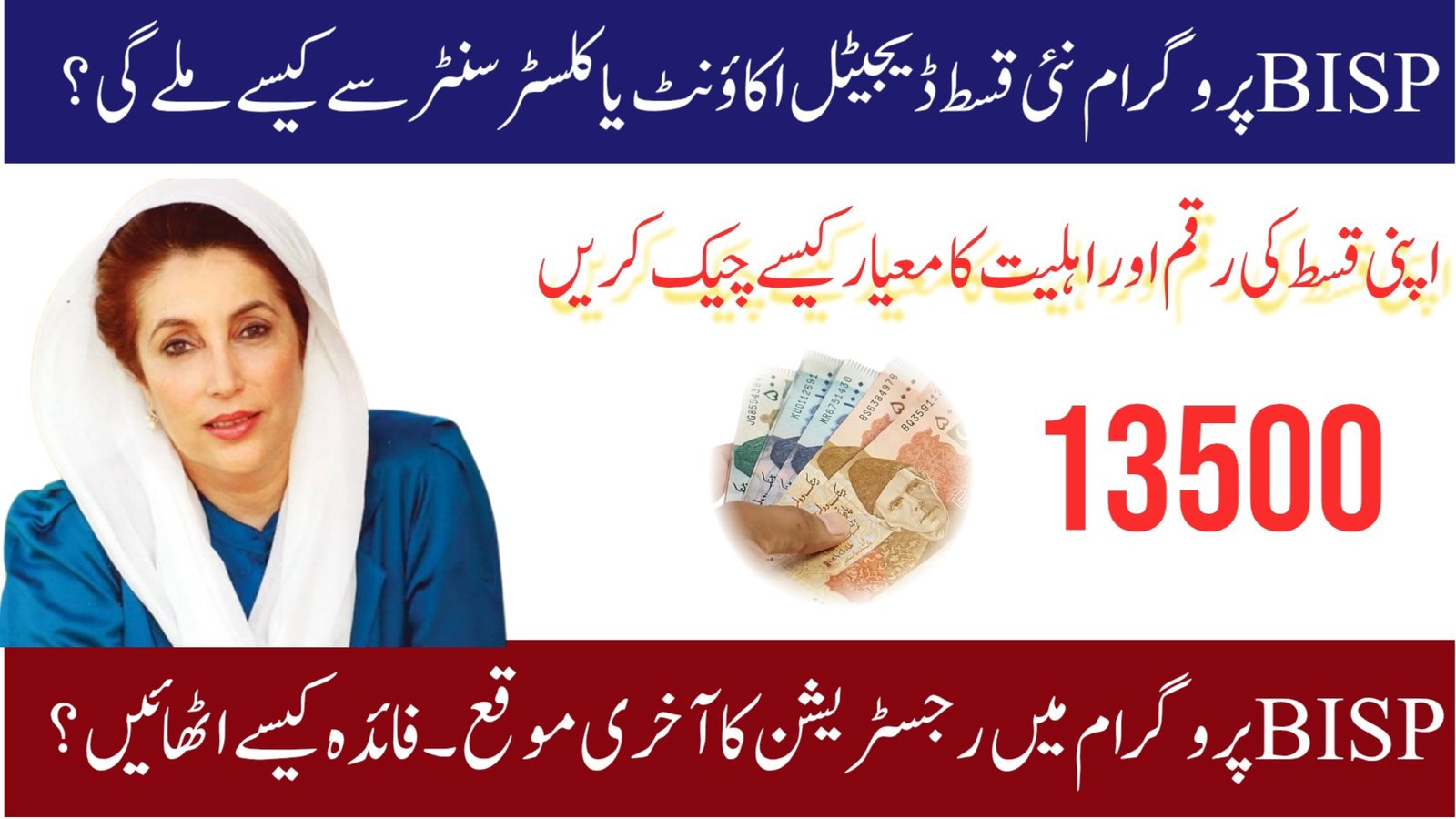The BISP 2025 Payment Cluster Distribution is a major welfare initiative by the Pakistani government, providing direct financial support to low-income families. In 2025, the installment has increased to Rs. 13,500 per eligible family, helping women meet the cost of food, education, and healthcare for their children. The new cluster-based payment system ensures that funds reach the right beneficiaries safely, avoiding overcrowding, fraud, or delays. This step improves transparency and efficiency while empowering women across Pakistan. Families can check their eligibility and cluster online via the official BISP 8171 portal.
| Feature | Details |
|---|---|
| Payment Amount | Rs. 13,500 per family |
| Distribution System | Cluster-based by district |
| Payment Partners | HBL, Bank of Punjab, JazzCash, Easypaisa, Habib Microfinance |
| Beneficiaries | Women from low-income households |
Key Highlights of BISP October 2025 Payment
The BISP October 2025 Payment comes with several improvements for easier access:
- Installment: Rs. 13,500 per eligible family
- Distribution: Cluster-based by district
- Main Partners: HBL, Bank of Punjab, JazzCash, Easypaisa, Habib Microfinance
- Eligibility Check: Official 8171 portal and SMS
- Target Group: Women from low-income households
These updates make it simpler for women to know exactly when and where to collect their payment while reducing dependency on intermediaries.

What Has Changed in the BISP 2025 Payment Schedule?
The 2025 schedule introduces better organization through clusters, grouping districts under specific banks or mobile wallets. Previously, long queues and agent interference caused delays and frustration.
Now, each cluster follows its own timetable, allowing beneficiaries to confirm their cluster and assigned bank in advance. The increase in installment to Rs. 13,500 also reflects the government’s response to rising inflation, ensuring vulnerable families receive meaningful support.
How the BISP Cluster Distribution System Works
The cluster distribution system manages payments efficiently by assigning groups of districts to specific banks or mobile wallets. Each cluster has a schedule, reducing crowding at payment centers and preventing fraud.
- Organized payment release by district
- Reduced crowding at branches and campsites
- Transparency in bank and wallet assignments
- Clear instructions for beneficiaries
- Protection from unauthorized agents
Women can check their cluster and status online at the 8171 portal to ensure a smooth payment process.
BISP 2025 Cluster Assignments and Partner Banks
Here is the updated district-wise cluster table with actual districts assigned to payment partners:
| Cluster | Partner Bank/Wallet | Districts | Status |
|---|---|---|---|
| 1 | HBL | Rawalpindi, Islamabad, Attock, Chakwal, Jhelum | Released |
| 2 | Bank of Punjab | Multan, Bahawalpur, Khanewal, Muzaffargarh, Lodhran | Ongoing |
| 3 | JazzCash | Karachi Central, Karachi East, Karachi West, Karachi South, Malir | Pending |
| 4 | Easypaisa (Telenor) | Larkana, Shikarpur, Jacobabad, Khairpur, Ghotki | Released |
| 5 | Habib Microfinance | Nawabshah, Dadu, Jamshoro, Matiari, Mirpur Khas | Ongoing |
Beneficiaries must confirm their actual cluster on the official 8171 portal before visiting any branch or agent.
How to Check Your BISP Eligibility Step by Step
To receive your Rs. 13,500 payment, check your eligibility easily from home:
- Visit the official 8171 Web Portal
- Enter your CNIC without dashes
- View eligibility status and cluster details
- Wait for the official SMS confirming release date and location
- Only visit the assigned branch or wallet agent
Following this method ensures safe and accurate payment collection.
How to Collect BISP Rs. 13,500 Payment Safely
Once your SMS confirms the payment release, follow these steps:
- Go to your assigned bank, wallet agent, or camp site
- Bring your original CNIC
- Complete biometric verification using your thumbprint
- Receive your Rs. 13,500 installment
- Keep the receipt or SMS as proof
Never give money to intermediaries. If anyone attempts to take a share, report it to the nearest BISP office.
What to Do If You Face Delays?
Delays may occur due to cluster scheduling. Steps to follow:
- Re-check your CNIC status on the 8171 portal
- Ensure your mobile SIM is registered and active
- Update biometric verification if needed
- Visit the nearest BISP office if issues continue
- Avoid unauthorized agents promising faster payments
How to Apply or Re-Register for BISP 2025
Families not yet registered can join easily:
- Visit the nearest BISP registration center
- Bring your CNIC and family details
- Fill out the NSER survey for verification
- Wait for official 8171 SMS approval
- Start receiving payments in the next cycle
Why the BISP 2025 Program Matters
The BISP 2025 Program empowers women, protects low-income families, and ensures aid reaches those most in need. The cluster system guarantees transparency, removes middlemen, and distributes Rs. 13,500 per eligible family directly. This program improves living standards, supports children’s education, and strengthens healthcare for vulnerable households across Pakistan.
Conclusion
The BISP 2025 October Payment Schedule with the new cluster distribution system ensures safe, transparent, and organized payments. Eligible women can now check their cluster online, receive SMS notifications, and collect Rs. 13,500 without facing fraud or delays. Families not registered should complete the NSER survey for future cycles. Using official channels guarantees that financial aid reaches the right beneficiaries and supports women in managing family needs effectively.
FAQs
Q1: What is the new BISP installment amount?
Rs. 13,500 per eligible family.
Q2: How do I check my BISP eligibility?
Visit the official 8171 portal with your CNIC.
Q3: What is the cluster system?
A model that groups districts under specific banks or wallets for organized payments.
Q4: Can new families apply for BISP 2025?
Yes, by visiting the nearest BISP registration center and completing the NSER survey.
Related Posts











